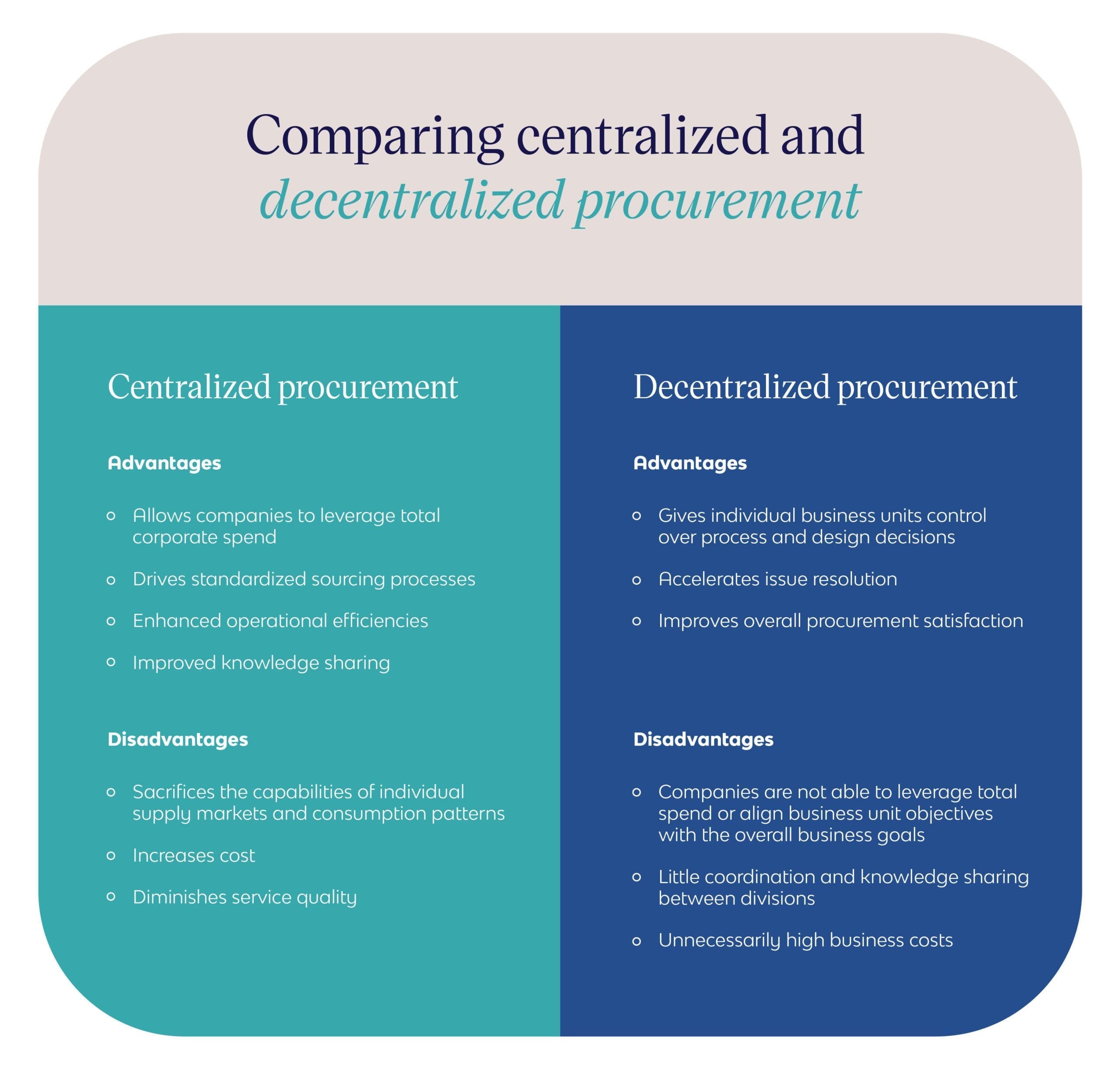Center Led Procurement: An Introduction
Corcentric

Realizing the Full Benefits of Center-Led Procurement
As procurement organizations of all sizes and maturity levels embark on transformation projects, many consider it within scope to re-evaluate the structure of their team and how procurement interacts with the rest of the enterprise. Center-led procurement has been considered a best practice for some time now, preferable to both centralized and decentralized procurement structures. And yet, procurement must be constantly re-evaluating their structure and priorities.

First, some procurement definitions:
- Center-led procurement: strategic decisions are coordinated centrally while transactional work is executed in a distributed fashion. This is especially common in large enterprises (>1 billion dollars).
- Centralized procurement: all purchases go through a single, dedicated organization
- Decentralized procurement: each business, functional or geographic unit is responsible for its own purchases
The Advantages
Centralized procurement allows the enterprise to leverage total corporate spend and drive standardized sourcing processes throughout the organization. The resulting economies of scale allow the company to wield the full power of their spend, enhance operational efficiencies, and improve knowledge sharing and best-practice execution.
Decentralized procurement empowers individual business units, giving them (or allowing them to keep) control over their process and design decisions. Unsurprisingly, it also improves their overall satisfaction with procurement. Working ‘locally’ speeds issue resolution and allows the organization to take advantage of applicable expertise on a detailed level.
The Disadvantages
Centralized and decentralized procurement each have a ‘fatal flaw’ – a characteristic that prevents them from delivering the same total value as the center-led model.
Centralized procurement sacrifices the extensive capabilities of individual supply markets and consumption patterns. This often results in suboptimal buys for many regions and poor satisfaction. The risk of maverick buying increases when your geographically dispersed site managers do not agree with centrally mandated decisions and this impacts local supply, quality or reaction times. Centralized procurement of commodities and services ill-suited for centralized buying can actually increase costs and/or diminish service quality. Reaction times to unexpected changes in supply or demand can be delayed, which is critical if your profit margins depend on demand-driven supply strategies.
Decentralized procurement does not allow the company to leverage their total spend or align business unit objectives with those of the enterprise. There is little coordination or knowledge sharing between divisions, and specifications and supplier performance are often inconsistent. In a death blow to the most fundamental procurement mandate, operating costs unnecessarily high because of the lack of standardization and volume leveraged buying.
Rounding out Center-Led Procurement
Center-led procurement offers all the advantages of both the centralized and decentralized models with minimal disadvantages. It provides a procurement center of excellence (COE) focused on supply chain optimization and strategic commodities, best practices and knowledge sharing. It leaves individual purchasing decisions and tactical execution to the individual business units. A cloud-based procurement solution with a single source of verified Master Data is requisite for making this happen.
The center-led model is built on cross-functional teams that represent all key divisions and business units. It allows for the creation of flexible processes and category strategies that can be tailored to adhere to local regulations or take advantage of local markets or tax breaks. Corporate spend can be fully leveraged through centralized sourcing while smaller categories unsuitable for centralized sourcing can be handled by individual business units. Operational efficiencies go up while operational costs go down – all while maintaining agility in the face of unexpected changes in supply or demand.
In Ardent Partners’ Four Pillars of Sourcing Success report, they reveal that organizations with center-led procurement considerably outperform their counterparts in spend under management and supply cost reductions. Center-led companies report more than twice as much spend under management than companies with a decentralized structure and nearly 20% more spend under management than companies with a centralized structure. Center-led companies also report 5% to 20% cost savings for each new dollar of spend brought under management.
While center-led procurement seems to stand out as the obvious path to follow, both the centralized and decentralized models have advantages that have to be addressed or absorbed to make center led as successful as it can be. Companies that have had center-led procurement for some time must make sure they do not lose the advantages of the other models in the long run.
If you would like to see first-hand how Corcentric can help optimize your full Source-to-Pay, Order-to-Cash, and AP Automation processes, schedule a personalized demonstration.